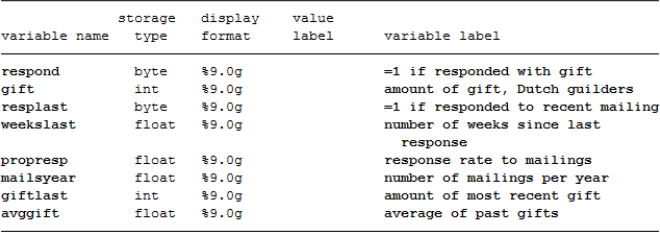ECON3208 Applied Econometric Methods Assignment 2 2024
Hello, dear friend, you can consult us at any time if you have any questions, add WeChat: daixieit
Assignment 2
Suppose that you want to investigate how various factors may help explain people’s decisions about charitable donations. You have a random cross-sectional sample drawn from 4,268 individuals living in Holland, which may help you understand how individuals respond to charity requests. The sample is stored in the file charity.dta, which includes 8 variables defined in the table below.

It has been suggested that the variables in x = [1, replast, weekslast, propresp, mailsyear, avggift] be used to explain the dependent variable respond or gift, where “1” represents an intercept. It has also been suggested that mailsyear be treated as a continuous variable.
(a) Comment on the summary statistics of the data, including but not limited to features of the variables (respond, gift , propresp).
(b) Interpret the β parameters in the following linear model:
respond = β0 + β1 resplast + β2 weekslast + β3propresp + β4 mailsyear + β5 avggift + u,
where u is the error term, and β’s are constant parameters. What are your expectations about the signs of (β1, β2, β3, β4, β5)? Estimate this model by OLS and report the results in equation form, including the sample size and R2. Comment on the estimation results.
(c) What is the main drawback of the model in (b)?
(d) Estimate the probit model below by ML:
E(respond |x) = Φ(β0 + β1 resplast + β2 weekslast + β3propresp + β4 mailsyear + β5 avggift),
where Φ(.) is the standard normal CDF. Report the results in equation form, including the sample size and R2 . What is the pseudo R-squared here? Comment on the estimation results. Find and interpret the average partial effect (APE) of mailsyear onE(respond |x).
(e) Do the parameters (β1, β2, β3, β4, β5) in (d) have the same interpretations as they did in (b)? How would you compare β estimates in (d) to those in (b)? How would you compare the partial effect of mailsyear on E(respond |x) in the probit model against that in the linear model for respond in (b)?
(f) Redo (b) using gift as the dependent variable. Comment on the main merits or drawbacks of the linear model for gift.
(g) Estimate the Tobit model for gift, using x = [1, replast, weekslast, propresp, mailsyear, avggift]
as the explanatory variables. Report the β estimates, their standard errors, the sample size, and R2 . Comment on the estimation results. Find and interpret the APE of mailsyear onE(gift |x).
(h) For the Tobit model in (g), find the formulae for the conditional probability P( gift = 0|x) and the partial effect of mailsyear onE(gift| x), respectively.
(i) How would you compare the estimates of the β parameters in (d) to their counterparts in (g)?
(j) Perform the LR test to determine if there is statistical evidence against dropping (resplast, avggift) from the Tobit model in (g).
Notes on Assignment 2
. Assignment 2 is an exercise on the material covered in lectures through Week 5 (up to the end of Tobit models in Chapter 17). You are encouraged to start doing this assignment as early as possible.
. You may use Stata do-file “charity-assign2.do” to carryout the required computations for this assignment. However, you must study and understand the Stata commands in the do-file.
. Questions (a)-(j) will guide you through the tasks to be done, and help you understand and
practise what you have learned. By answering these questions, you gain insights about the data and the econometric methods you are using to analyse the data.
. No submission of your answers is required. Instead, your work on Assignment 2 is assessed by Quiz 2 on Assignment 2, which is an online quiz based on questions (a)-(j).
. You have 1 attempt of 30 minutes’ duration (in the 2-hour window of 8:00-10:00 on Thursday, March 28, 2024) to complete the 10 multiple-choice questions that makeup Quiz 2. Each question is worth 1.5 marks. An incorrect answer contributes nothing to your total quiz score. Your Quiz 2 result is your Assignment 2 result.
. The quiz assesses your understanding of the course material in the context of Assignment 2. For example, it may test your ability to summarise data characteristics, understand a model, implement estimation methods in Stata, interpret estimation results, and apply test procedures in the context of Assignment 2. The Stata commands used for this assignment may also be tested in the quiz.
. You should carry out the required computations, and carefully write down your answers to
questions (a)-(j). You should have your answers and Stata computation output handy before you attempt the quiz.
. The University regards plagiarism as a form of academic misconduct and has very strict rules regarding plagiarism. For UNSW’s policies, penalties, and information to help you avoid plagiarism see:https://student.unsw.edu.au/plagiarism.
About Stata Commands
. In estimating the models (either OLS or ML), it is preferable to use robust standard errors. This can be done by using commands similar to the following, with the option “vce(r)” .
regress y x1 x2,vce(r) //for OLS
probit y x1 x2,vce(r) //for probit ML
tobit y x1 x2,ll vce(r) //for Tobit ML
. To find average partial effects for probit or Tobit, use commands similar to the following.
probit y x1 x2,vce(r) // for probit ML
margins, dydx(*) //APE for all (all regressors assumed to be continuous)
tobit y x1 x2,ll vce(r) //for Tobit ML
margins, dydx(*) predict(ys(0,.)) //APE for all (all assumed to be continuous)
It may also be beneficial to consult the do-files for the examples used in lectures in Weeks 4-5.
2024-03-18